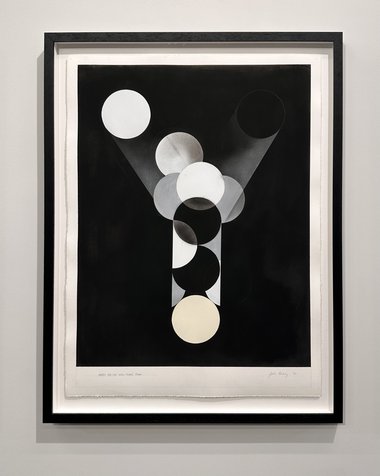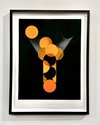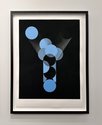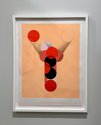John Hurrell – 2 April, 2023
Moving well away from musical resonances towards a more political conversation that examines the organisational nature of the paintings, it has occurred to me that the use of the letter ‘Y' in most (not all) of these stunningly precise works, presents in this show an aural pun on the word ‘Why?', suggesting that we question our love of visuality and Art's ideas—and even the self-questioning process we are entangled in, that contemporary art encourages.
Auckland
John Bailey
GYMNOSPHERE / Notes for the well-tuned piano
25 March 2023 - 8 April 2023
Possibly alluding to Russian Constructivism, John Baldessari, municipal traffic lights, or perhaps—from the ridiculous to the cosmic sublime—Sephirotic mysticism, these flashe acrylic and charcoal on paper works by John Bailey (with their precise vertical and balanced alignments of flat [occasionally smokey] densely coloured discs) might look initially like bland design; in the worst sense of decorative decor. However concentrated inspection soon reveals highly nuanced tonal manipulation, inventive composition and surprising emotional intensity. That these fastidiously executed paintings are inspired by music, especially that of Bay Area minimalist composer and pianist, Jordan De La Sierra, is easy to understand.
When De La Sierra’s double album, Gymnosphere / Song of the Rose, was originally released in 1977 it was not a commercial success, maybe due to similarities between De La Sierra’s work and Harold Budd’s collaborations with Brian Eno. Re-released in 2014 it had a booklet of the artist’s linear India-inspired figurative drawings that to me come across as New Agey and corny. Bailey’s painted and drawn works, referencing that album and presented here with Lawrie, are definitely not so.
Bailey is remembered by older Auckland art enthusiasts for his wall drawings at Peter Webb in 1980, inspired by Bochner and Lewitt and using mathematical systems and in situ architectural dimensions. This current show of nearly a dozen works is very different in mood, but it continues his interest in flat shape, systems and process, through the tonal groupings and structures of the overlapping or stacked circles and the faint linear traces of charcoal. And it seems, furtively references the viewing experience and (very slyly) its social context.
Moving well away from musical resonances towards a more political conversation that examines the organisational nature of the paintings, it has occurred to me that the use of the letter ‘Y’ in most (not all) of these stunningly precise works, looks at a fork in the road requiring a directional decision, or as a ‘forked tongue’, revealing itself to be an outright lie. For Bailey though, the Y , when thinking of De La Sierra’s music, is ‘yes’, affirmative, a positive thing.
It also more importantly presents in this show an aural pun on the word ‘Why?’, suggesting that we question our love of visuality and Art’s ideas—and even the self-questioning process we are entangled in, that contemporary art encourages. Art here is like Uncle Remus’ Tar Baby, that we (in the Art Cult) can’t let go. The works (I openly speculate) tell us to cross-examine the act of interrogation? We wonder: does Art really have to pull itself to pieces?
Is Bailey in his use of this particular letter shape, being subversive? Expressing something far more complicated than simple self-doubt; in fact pulling the carpet out from under the viewer; ambiguously taking a blow torch to ocular pleasure (even when it is structurally like music) and also cerebral interpretation-based mind games. Is Bailey (despite his love of making Art) calling the Art Community (of which this writer is a member) a bunch of wankers, while cheerfully admitting he is one himself?
It’s a clever multi-voiced show, with more involved than homage to music.
John Hurrell







 Two Rooms presents a program of residencies and projects
Two Rooms presents a program of residencies and projects Advertising in this column
Advertising in this column



This Discussion has 0 comments.
Comment
Participate
Register to Participate.
Sign in
Sign in to an existing account.